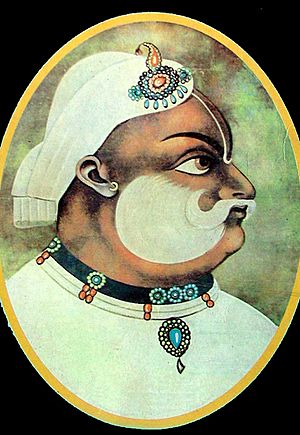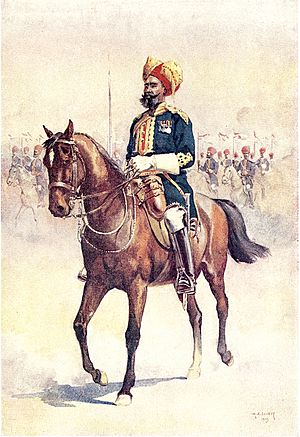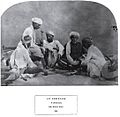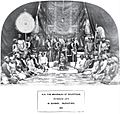Jat people facts for kids

Maharaja Suraj Mal, the 18th century Hindu Jat ruler of Bharatpur
|
|
| Regions with significant populations | |
|---|---|
| India and Pakistan | |
| Languages | |
| Haryanvi • Hindi • Punjabi • Rajasthani • Sindhi • Urdu | |
| Religion | |
| Hinduism • Islam • Sikhism |
The Jat people are a traditionally agricultural community in Northern India and Pakistan. Originally pastoralists in the lower Indus river-valley of Sindh. Jats migrated north into the Punjab region, Delhi, Rajputana, and the western Gangetic Plain in late medieval times. Primarily of Hindu, Muslim and Sikh faiths, they now live mostly in the Indian states of Haryana, Punjab, Delhi, Rajasthan and Uttar Pradesh and the Pakistani provinces of Punjab and Sindh.
Traditionally involved in peasantry, the Jat community saw radical social changes in the 17th century, when the Hindu Jats took up arms against the Mughal Empire during the late 17th and early 18th century. The Hindu Jat kingdom reached its zenith under Maharaja Suraj Mal of Bharatpur (1707–1763). The Jat community of the Punjab region played an important role in the development of the martial Khalsa Panth of Sikhism; they are more commonly known as the Jat Sikhs.
By the 20th century, the landowning Jats became an influential group in several parts of North India, including Haryana, Punjab, Western Uttar Pradesh, Rajasthan, and Delhi. Over the years, several Jats abandoned agriculture in favour of urban jobs, and used their dominant economic and political status to claim higher social status.
Military
A large number of Jat people serve in the Indian Army, including the Jat Regiment, Sikh Regiment, Rajputana Rifles and the Grenadiers, where they have won many of the highest military awards for gallantry and bravery. Jat people also serve in the Pakistan Army especially in the Punjab Regiment.
The Jat people were designated by officials of the British Raj as a "martial race", which meant that they were one of the groups whom the British favoured for recruitment to the British Indian Army. The Jats participated in both World War I and World War II, as a part of the British Indian Army. In the period subsequent to 1881, when the British reversed their prior anti-Sikh policies, it was necessary to profess Sikhism in order to be recruited to the army because the administration believed Hindus to be inferior for military purposes.
Images for kids
-
Jat Sikh of the "Sindhoo" clan, Lahore, 1872
-
The Hindu Jat Maharaja of Bharatpur, 1882
-
The Sikh Jat Maharaja of Patiala, 1898
-
Chaudhary Charan Singh, the first Jat Prime Minister of India, accompanied by his wife, on his way to address the nation at the Red Fort, Delhi, Independence Day, 15 August 1979.
-
A contingent of the Jat Regiment of Indian Army, during the Republic day parade
-
The durbar of the teenage Hindu Jat ruler of Bharatpur, a princely state in Rajasthan, early 1860s.
See also
 In Spanish: Jat para niños
In Spanish: Jat para niños









